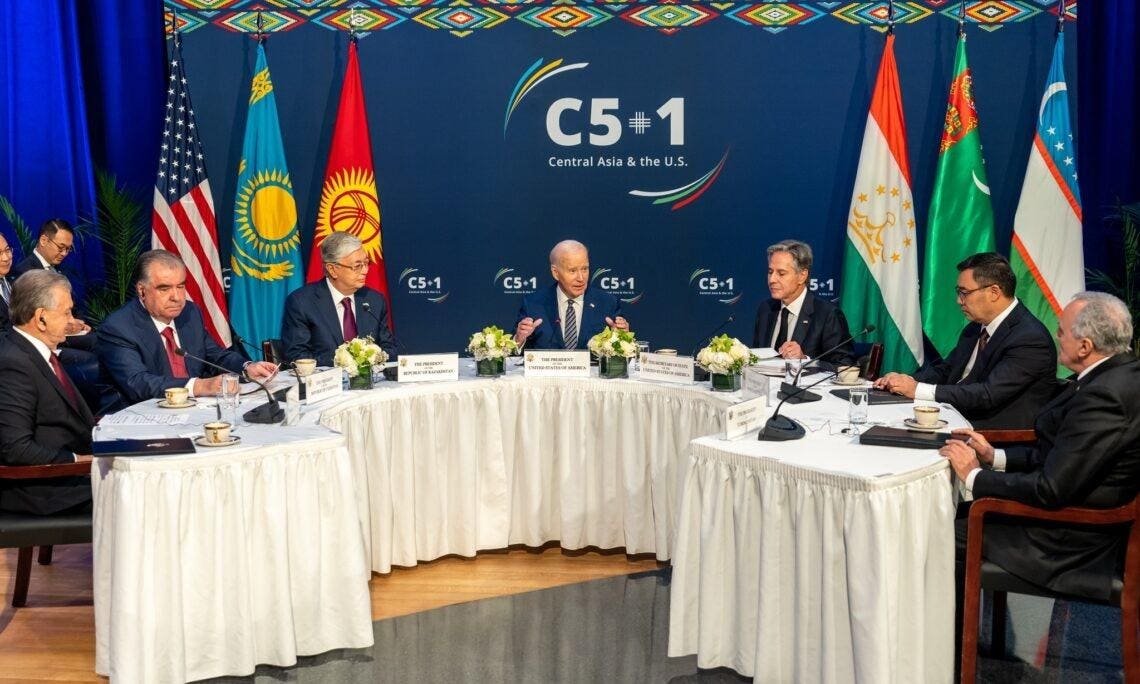President Joe Biden hosts a meeting with central Asian presidents for the Central Asia 5+1 Summit, … [+] Tuesday, September 19, 2023, at the U.S. Mission to the United Nations in New York City. (Official White House Photo by Adam Schultz)
In Central Asia, everyone appears to be moving to secure riches and interests. Japan has just conducted an investment summit with the Central Asian states to develop economic opportunities, China’s Xi is expanding business ties, the EU is inaugurating a new strategic summit, and Vladimir Putin will be visiting in November. The world understands Central Asia and the role trade plays at this strategic pivot point, except, seemingly, Washington
Trade is the most effective tool for international engagement at the disposal of the United States, allowing it to conduct soft power diplomacy to America’s advantage. Permanent normal trade relations ensure that countries with this status indefinitely receive equal treatment and benefits. Concerning geopolitically vital Central Asian states, this remains poorly understood in Washington. This region, surrounded by Iran, Afghanistan, Russia, and China, must be a critical locus for American foreign policy. Instead, a well-intentioned but outdated law hobbles America’s trade and investment in the region, leaving the area to the tender mercies of Moscow and Beijing.
The Jackson-Vanik Amendment, originally designed to withhold PNTR from the Soviet Union for its refusal to allow Jewish emigration, still applies to several US strategic partners in Central Asia, including Kazakhstan and Uzbekistan, despite its irrelevance. Not only do these two secular, majority Muslim states not prohibit Jewish emigration, but one of them—Kazakhstan—actually hosts a pilgrimage site for the Chabad denomination with thousands attending every year.
Trade ensures access to vital raw materials. The most practical advantage derived from PNTR with Central Asia lies in the resources they can offer. For example, the region is incredibly rich in critical minerals, inputs for high-tech industries and the green transition. China’s monopolistic control over the supply chain of these minerals has allowed it an iron grip over these high-impact industries, making a secure supply chain from alternative sources required.
Central Asia is also a hub for other energy resources, including vast reserves of hydrocarbons. Kazakhstan stands out as the region’s primary petroleum supplier, with the U.S. already heavily investing in the oil and gas industry.
New opportunities for American investors in solar, wind, and hydroelectric energy abound, as reflected in Kazakhstan’s 2029 Development Plan, which prioritizes investment in the green energy sector. If the U.S. does not seize these opportunities, others will seize them, as in neighboring Uzbekistan, where a massive solar power project attempted to attract American investment. Instead, a UAE-Japanese-Dutch consortium will now reap the profits.
The world needs more electricity, especially with the growth of AI and EVs. Kazakhstan, and to a lesser degree Uzbekistan, also warrant engagement for their nuclear potential. Kazakhstan is the world’s largest producer of uranium, whereas China is already producing reactor fuel assemblies, and Russia dominates the civilian nuclear supply chain. In May, Russia signed an agreement to build a nuclear power plant in Uzbekistan. In October, Kazakhstan will hold a referendum on constructing a nuclear power reactor which may open new opportunities in the nuclear energy industry. While Moscow and Beijing leverage their relationships to secure access to uranium, the American nuclear industry faces supply shortages after prohibiting imports of Russian uranium.
Workers work at a nuclear fuel assemblies plant built by a Chinese-Kazakh joint venture in … [+] Ust-Kamenogorsk, Kazakhstan, Nov. 10, 2021. With an operation period of 20 years, the project is jointly funded by CGNPC Uranium Resources and Kazakhstan’s national atomic company Kazatomprom. (CGNPC/Handout via Xinhua)
The U.S. needs to secure essential resources in Central Asia or risk adversarial powers tightening their grip on supply.
Transportation is key to economic development and exports. Central Asia’s geographical position is a significant factor in its strategic value. The Middle Corridor, a proposed transportation network linking markets in Europe and China through Central Asia and the Caucasus, presents the opportunity for U.S. companies to build infrastructure in the region.
Beijing’s involvement in constructing infrastructure as a part of the Belt and Road initiative has expanded its influence. There is still room for Western companies to develop transportation infrastructure, with Kazakhstan’s 2029 Development Plan envisioning new projects and over 5,000 km of new railroads planned for construction by 2030. American logistics company Wabtec is already trying to mitigate this. Statements from Uzbekistan’s recent Tashkent International Forum have identified outdated infrastructure as priorities.
Wabtec’s Lokomotiv Kurastyru Zauyty (LKZ) plant in Astana, Kazakhstan.
Geopolitics matter. Strengthening American presence in Central Asia will dilute Russia’s influence in its former colonies. Russia’s clout over Central Asia has weakened as a result of its invasion of Ukraine, with neighbors like Kazakhstan showing an increased willingness to engage with the West. Despite the war’s adverse effect on Russia’s relationship with Central Asian states, they still serve as an economic lifesaver for Moscow, mainly because of geography and a cold shoulder from possible alternatives.
Jackson-Vanik hampers American companies seeking to enter the region and take advantage of initiatives such as the administration’s “Build Back Better World,” the U.S. answer to China’s BRI. The United States’ failure to repeal the Jackson-Vanik Amendment hamstrings American economic and strategic interests. Delays in extending PNTR to its strategic partners signal the U.S. won’t take a simple, no-cost political action to promote American national interests. Moscow and Beijing couldn’t ask for better policies. The time to correct this error is now, as the opportunities presented by fostering stronger ties in Central Asia will not wait for American policymakers to catch up. Kazakhstan is ready for the full PNTR status, and Uzbekistan can follow when it joins the WTO.
